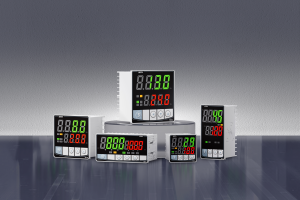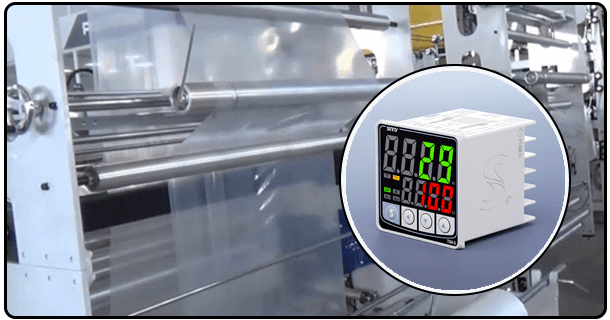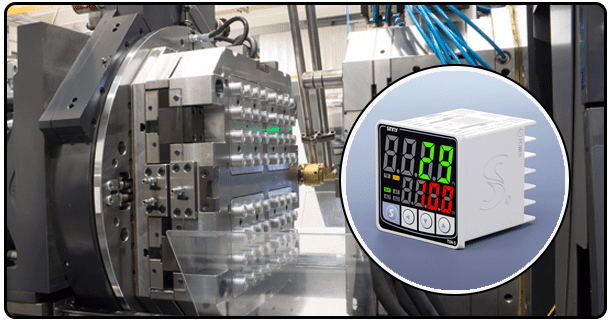The PID temperature controller with Ethernet: Benefits and Features
1. Introduction
In many industrial, commercial, and scientific applications, precise temperature regulation is essential. Within this domain, the Proportional-Integral-Derivative (PID) temperature controller stands out as a cornerstone technology, renowned for its effectiveness in maintaining desired temperature setpoints. These controllers have traditionally relied on the local interface for monitoring and operation. Ethernet connectivity, however, has greatly enhanced their capabilities. It offers unprecedented flexibility, remote accessibility, and integration possibilities. The article explores PID controllers with Ethernet capabilities. This article explores their hardware and software core components. It also examines how Ethernet enables advanced features. This technology is essential for managers, engineers and technicians who work in areas where maintaining temperature is a priority.
2. Parts and Components
The PID controller for Ethernet consists of several hardware components that work together. To make it easier to understand, the primary components are grouped into broad categories.
A. The main controller unit is located at the core of the system. It can be a Programmable Logic Controller or a microcontroller. The main controller unit is responsible for the entire operation. It receives temperature measurements, executes the PID algorithm, calculates the output and manages communication. Most modern controllers use robust platforms that can handle complex logic and networking protocols.
B. Temperature sensors: The choice of temperature sensor is heavily dependent on both the application and environment. Thermocouples are commonly used because of their long-lasting durability, Resistance Temperature Detectors, or RTDs, for high accuracy and thermistors for their sensitivity in lower temperatures. The sensors are used to convert the temperature changes into electrical signals which can be fed to the controller.
C. Actuation devices: To adjust temperature, the controller output needs to be translated into physical actions. The controller is connected with actuators, like heating elements such as resistive coils and quartz lamps or cooling devices (like fan-based coolers or refrigeration units). To achieve a desired temperature, the controller modulates power to the devices in accordance with the PID algorithm output.
D. Ethernet Module: It is this feature which distinguishes Ethernet controllers from the traditional ones. Ethernet modules facilitate digital communication, usually using Ethernet/IP and Modbus TCP protocols. The module transmits data over twisted pair cables or fiber-optics. This allows long-distance communications and the integration of existing Local Area Networks or wider industrial networks.
E. Wiring and Power Supply: Each component requires a reliable and suitable power supply. Power supply units convert incoming power (e.g. AC mains electricity) into DC voltages required by controllers, sensors and Ethernet modules. To minimize interference noise and to ensure reliable transmission, it is important that the sensors and Ethernet are connected with shielded twisted pairs.
3. Algorithms and Software
Software and algorithms are the brains of the PID controller. Software dictates controller behaviour, while hardware is the foundation.
A. PID Control Algorithm: PID controls operate by continuously computing an error value, which is the difference between desired setpoint temperatures and actual measured temperatures. The PID controller then takes a corrective measure based on the three terms that are derived from this error.
Proportional(P): This expression provides an immediate reaction proportional to current error. The larger the error, the larger will be the corrective action. This helps to quickly reduce temperature deviation.
Integer (I): The term is used to describe the effect that past mistakes have had on the current error. The integral term adds the correction to any errors which have been present for some time.
Derived (D) The term is used to predict future errors by analyzing the change in the error rate. This term helps dampen system response by preventing oscillations and overshoot around the setpoint.
B. This algorithm is embedded in the firmware of the controller or the running software. The software receives temperature sensor signals, calculates PID terms and integrates these to produce the control output. It then sends that signal via the appropriate interface to the actuator (usually a Digital to Analog Converter or Pulse-Width Modulation output).
C. Ethernet communication protocol: Ethernet connectivity is structured by specific protocols for data exchange. Modbus TCP has become a favorite in industrial automation because of its ease-of-use and wide support. The protocol allows network devices to exchange messages using standard message formats. Ethernet/IP, developed by Automation Technology Council and widely used to connect industrial devices via Ethernet networks is another protocol.
D. The core functionality is the control. However, an interface is developed to perform the function. This is usually done on either a Human Machine Interface (HMI), or computer that is connected to the system. The interface allows the operator to adjust the PID parameters, view the system status and current temperature in real time, and set the desired temperature.
4. Ethernet Features
When Ethernet is integrated into the PID Controller, it transforms it from a stand-alone device to a component that can be networked. This unlocks a number of advanced features previously unavailable with analog communication or limited digital communications.
A. The ability to remotely monitor and control the controller is perhaps the biggest advantage Ethernet connectivity offers. Authorized personnel can use a web browser, or SCADA software to access controller statuses, make changes, modify parameters and receive notifications from anywhere connected to the internet.
B. Ethernet enables seamless data reporting and logging. The controller is able to record temperatures, setpoints and control outputs. These data can either be stored on the controller itself or sent to a server or database. It can then be used to generate operational reports, analyze process performance, identify trends and support compliance with regulatory needs (e.g. in pharmaceuticals or foods processing).
C. Networked PID Controllers are easily able to be integrated with larger enterprise systems. The integration allows better coordination of different control devices. It also links the operational data to enterprise resource planning systems.
D. Ethernet Security: Ethernet communication offers flexibility but also presents potential security weaknesses. Implementing appropriate security measures is essential to safeguard the controller from malicious interference, unauthorized data access or breaches. Use of firewalls and strong authentication is a common practice. Encryption for data transmission, such as HTTPS and VPNs, and regular firmware updates to fix security vulnerabilities are also practices.
5 .To ensure maximum performance and reliability, it is important to plan and execute the implementation of a PID controller using Ethernet.
A. Block Diagram: This diagram shows the architecture of the system, including the connection between the controller and the sensors or actuators, the Ethernet module, the user interface, as well as any other networked devices. This is a valuable visual tool during the design stage to understand data flow and component interaction.
B. Initial setup includes configuring controller parameters such as temperature ranges, sensor types and calibrations, setpoints, and gain values for PID (Kp Ki Kd). The network configuration is also important. This includes assigning a fixed IP address, configuring a DHCP for dynamic assignments, or setting communication protocols. This configuration can be done via an HMI, or by connecting a computer.
C. The accuracy of temperature control is dependent on calibrated sensors. In order to achieve accuracy, the calibration process requires comparing sensor readings with known reference points. It may be necessary to recalibrate regularly, particularly if the sensors are drifting over time or environmental conditions have changed significantly.
D. Problem-solving and maintenance: PID controllers that use Ethernet are no different than any other complex system. Sensor malfunctions, electrical errors, fluctuations in power supplies, communication problems, and incorrect parameter settings are all common problems. It is important to use a systematic approach for troubleshooting, which can be guided by diagnostic logs or messages provided by controller software. For long-term reliability, regular maintenance is essential. This includes cleaning sensors, checking connection, updating software/firmware and other tasks.
6. Applications and use cases
They are suitable for many applications in various industries due to their versatility and increased capabilities.
A. For industrial manufacturing processes, such as semiconductor manufacture, metal processing and chemical processing, temperature accuracy is crucial for consistency in reaction, materials properties and product quality. Ethernet controllers enable centralized monitoring of heating/cooling systems, improving efficiency.
B. Lab Research Environments: Many research facilities require temperature controls that are highly precise and stable for their experiments, storage of samples, and analytic equipment. The use of networked PIDs allows for remote monitoring and data collection, which can be used to analyze research. They are also integrated into automated experiment protocols.
C. HVAC Systems: Ethernet connectivity is a major benefit for HVAC systems. PID controllers, which are often used to manage chillers and boilers, can be extremely useful. It allows remote adjustment of heating and cooling settings, energy monitoring, integration with BMS, and predictive maintenance using operational data.
D. Environmental Control Systems: Applications such as incubators for biological growth, environmental chambers for material testing, and storage facilities for temperature-sensitive goods (e.g., pharmaceuticals, vaccines) rely on stable temperature environments. These systems require Ethernet connectivity to be monitored, as it allows for remote monitoring, automatic logging and compliance with storage regulations.
The Benefits of the Program
Ethernet integration into temperature controllers with PID offers many advantages over conventional controllers. It improves operational efficiency, system control and value.
A. Precision Temperature Regulation: When implemented correctly, PID algorithms offer highly accurate temperature regulation. This precision can be used across wider networks with Ethernet connectivity, which allows for coordinated control of multiple systems and points.
B. Improved Process Efficiency: Remote monitoring and access in real time allows operators to react quickly to any deviations, or to optimize processes using accurate data. Data logging and automated reporting are key to facilitating continuous improvement by giving insights on energy consumption and process performance.
C. Ethernet connectivity allows for improved safety and reliability. It can alert staff to any critical situation (e.g. temperature outside of range, sensor failure), regardless of where they are located. A centralized diagnostic and management system can also help to identify potential problems before they become major ones.
D. The initial cost may seem higher but the benefits over the longer term often outweigh it. Reduced waste and defects in products are the result of improved process control. Energy consumption is reduced when efficiency increases. Remote diagnostics and monitoring can save time and money by reducing the number of on-site inspections. A better maintenance schedule based on data from operational systems can also extend the equipment's lifespan.
7 .The integration of PID temperature controls with Ethernet connectivity represents a major advancement in the thermal control industry. These controllers combine robustness and accuracy of PID with flexibility, reach and the data handling power of networking. These devices provide significant advantages to operational efficiency, consistency of processes, and system management. They enable remote monitoring, data recording, seamless integration with corporate systems, as well as enhanced security. The PID temperature control with Ethernet will remain an essential tool as industries demand more precision, automation and connectivity.
Further Reading
Note: This section will list URLs and author names for academic articles, websites of manufacturers, whitepapers or case studies. )
A list of websites that are authoritative and contain documents and information on PID theory, controller models and Ethernet in automation.
Meta description:
Discover the benefits and features of PID controllers that have Ethernet connectivity. You will learn about the hardware, PID algorithms, system designs, remote monitoring, industry applications, HVAC and manufacturing, as well as how Ethernet can enhance precision temperature control.
- Understanding PID water temperature controller
- PID Temperature Controller Wiring Diagram 220V: A Detailed Guide























